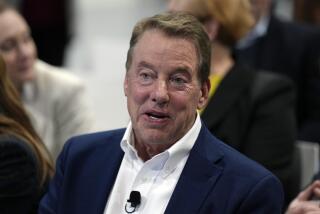Ford posts $5.8-billion deficit in third quarter
- Share via
Ford Motor Co. announced Monday that it lost $5.8 billion in the third quarter -- its largest quarterly deficit since 1992 -- as the automaker felt the pain of a restructuring plan that calls for substantial cutbacks at factories nationwide.
The slide downward is expected to last at least through the first half of next year as employee buyouts and plant closures continue and the No. 2 U.S. automaker struggles to wean itself from its reliance on pickup trucks and sport utility vehicles.
“Everyone expected the number to be bad,” said John Novak, an analyst with investment research firm Morningstar Inc. “But the amount of cash being burned is very high.”
Ford, based in Dearborn, Mich., reported that during the three months ended Sept. 30, its business operations -- excluding investing and financing activities -- paid out $3.1 billion more in cash than they brought in.
The company expects to have $26 billion in cash and available credit lines by year’s end, which Chief Financial Officer Don Leclair said would prove important to the company’s restructuring. He said Ford hoped to be profitable by 2009 and would spend $7 billion a year investing in new products to do so.
There was little market reaction to Monday’s report, with Ford shares slipping 11 cents, or 1.4%, to $7.90.
Third-quarter revenue fell 10% to $36.7 billion. U.S. vehicle sales fell 8.3% to 710,000, although the company said the year-earlier quarter was stronger than usual because of a promotion that gave all customers Ford’s employee price discounts.
The loss for the period, amounting to $3.08 a share, compares with a loss of $284 million, or 15 cents, a year earlier and brings Ford’s net loss for the year to $7.24 billion. Excluding one-time costs, Ford lost $1.2 billion in the quarter, or 62 cents a share, a penny lower than analysts’ consensus forecast.
Novak of Morningstar said other disappointments for the quarter included a lackluster performance at Ford’s financing unit, whose net income fell 55% from a year earlier to $262 million, and sluggish sales in the company’s luxury division, Premier Automotive Group, whose pretax loss rose more than fivefold to $593 million.
Ford also said it would restate earnings for the last five years because of accounting errors related to derivative transactions. The company said the restatements, which it will announce when it files its detailed quarterly report in November, would materially improve results for 2002, although it was too soon to tell how other results would be affected.
Novak said investors were not yet giving up on the company but instead were waiting to see what changes would be implemented by Alan Mulally, a former Boeing Co. executive named last month to succeed William Clay Ford Jr. as chief executive.
Although changes could be slow to occur, Mulally was emphatic Monday that they were needed.
“Let me make it clear: These results are unacceptable,” Mulally said in a conference call with investors and reporters. “But we are committed to moving from here to create a viable business going forward.”
Ford has struggled to maintain its place in the crucial U.S. market as it loses market share to foreign-based rivals.
In January the company unveiled Way Forward, a sweeping turnaround plan under which Ford said it would eliminate 30,000 jobs by 2012 and close 14 plants.
Lower-than-expected sales of pickups and SUVs in the first half of the year prompted the company to accelerate those cuts in September. Ford added two factories to the closure list, offered buyouts to all 75,000 of its union workers and said it would cut 14,000 white-collar jobs.
The process is well underway. Ford said Monday that 40% of the 10,400 factory employees it had taken back from Visteon Corp., the troubled parts subsidiary it spun off in 2000, had agreed to take buyouts, slightly more than it had expected.
But analysts said that relying on cutbacks alone wouldn’t cut it.
“At some point, this has to be a company about building a profitable product, not just shrinking,” said Kevin Tynan, a senior auto analyst with Argus Research. “You have to put some meat on the bones, and that’s really where the challenge lies.”
Ford’s focus on traditional bestsellers such as the F-150 pickup and the Explorer and Expedition SUVs has put it at a disadvantage in a time of persistent high gasoline prices. Although the company unveiled a crossover utility vehicle, the Edge, last week to positive reviews, it has little else notable in the pipeline, analysts said.
“They’re suffering a dry spell in new models in 2006,” said David Healy, an auto industry analyst with Burnham Securities. He said that rather than new ideas, Ford’s lineup relied on derivations of older models.
Even as the company implements changes, Ford faces stiff competition.
Domestic rivals General Motors Corp. and Chrysler Group have cut costs and unveiled new models more quickly than Ford has, Healy and other analysts said. At the same time, foreign competitors led by Toyota Motor Corp. are producing the fuel-efficient cars that customers are increasingly finding more appealing.
*







